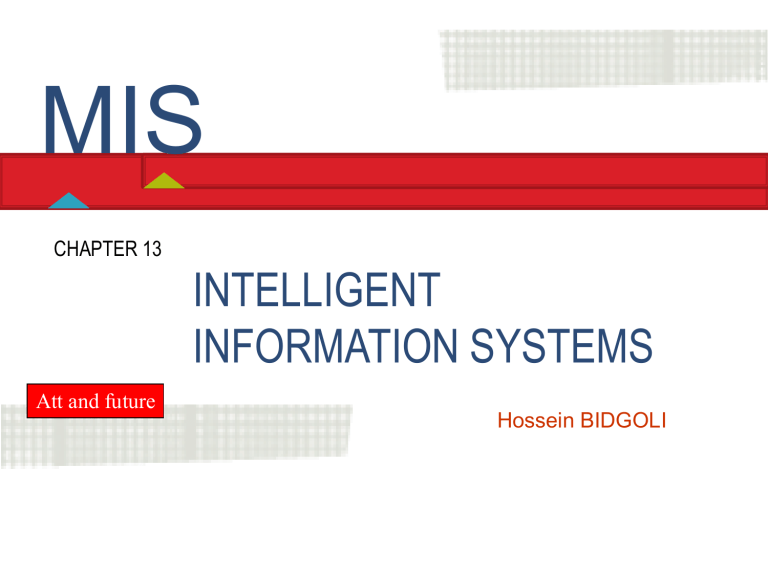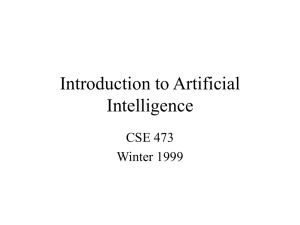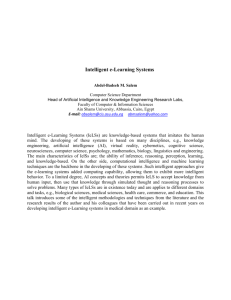Chapter 13 Intelligent Information Systems

MIS
CHAPTER 13
INTELLIGENT
INFORMATION SYSTEMS
Att and future
Hossein BIDGOLI
Chapter 13 Intelligent Information Systems l e a r n i n g o u t c o m e s
LO1 Define artificial intelligence and explain how these technologies support decision making.
LO2 Explain an expert system, its applications, and its components.
LO3 Describe case-based reasoning.
LO4 Summarize types of intelligent agents and how they’re used.
LO5 Describe fuzzy logic and its uses.
Chapter 13 Intelligent Information Systems l e a r n i n g o u t c o m e s (cont’d.)
LO6 Explain artificial neural networks.
LO7 Describe how genetic algorithms are used.
LO8 Explain natural language processing and its advantages and disadvantages.
LO9 Summarize the advantages of integrating AI technologies into decision support systems.
Artificial intelligence (AI)
◦ Consists of related technologies that try to simulate and reproduce human thought and behavior
◦ Includes thinking, speaking, feeling, and reasoning
AI technologies
Concerned with ______________ and displaying knowledge and facts
Capabilities of these systems have improved in an attempt to close the gap between artificial intelligence and human intelligence
Att and future
Decision makers use information technologies in _____________-making analyses:
◦ What-is (TPS)
◦ What-if (DSS)
Other questions:
◦ Why?
◦ What does it mean?
◦ What should be done?
◦ When should it be done?
Table 13.1
Applications of AI Technologies
Perform well at simple, repetitive tasks
Currently used mainly on assembly lines in
Japan and the United States
Cost of industrial robots
Some robots have limited vision
Mimic human expertise in a field to solve a problem in a well-defined area
Consist of programs that mimic human thought behavior
◦ In a specific area that human experts have solved successfully
Work with ________________
Knowledge acquisition facility
Knowledge base
Factual knowledge
Heuristic knowledge
Meta-knowledge
Knowledge base management system (KBMS)
Explanation facility
Inference engine
Exhibit 13.1
An Expert System Configuration
Airline industry
Forensics lab work
Banking and finance
_________________________
Food industry
Personal management
Security
US Government
Agriculture
Human _____________ is needed but one expert can’t investigate all the dimensions of a problem
Knowledge can be represented as rules or heuristics
Decision or task has already been handled successfully by human experts
Decision or task requires consistency and standardization
Subject domain is limited
Decision or task involves many rules and complex logic
Scarcity of experts in the organization
Very few rules
Too many rules
Well-structured ______________ problems are involved
Problems are in areas that are too wide and shallow
Disagreement among experts
Problems are solved better by human experts
Never becomes ______________, forgetful, or tired
Duplicates and preserves the expertise of scarce experts
Preserve the expertise of employees who are retiring or leaving an organization
Creates consistency in decision making
Improves the decision-making skills of nonexperts
Bots (short for robots)
Applications of artificial intelligence
Are becoming more popular
◦ Particularly in e-commerce
Consist of software capable of reasoning and following rule-based processes
Help users navigate through the vast resources available on the Web
Provide better results in finding information
Examples
◦ PriceScan
◦ BestBookBuys.com
◦ www.mysimon.com
◦ DogPile
Searches the Web by using several search engines
Eliminates duplicate results
Agents perform specific tasks for a user
Such as:
◦ Remembering information for filling out Web forms
◦ Completing e-mail addresses after the first few characters are typed
Work with a data _________________
Detect trend changes
Discover new information and relationships among data items that aren’t readily apparent
Having this information early enables decision makers to come up with a solution that minimizes the negative effects of the problem
Track and report on computer equipment and network systems
◦ To predict when a system crash or failure might occur
Example: NASA’s Jet Propulsion Laboratory
Allows a smooth, ________________ transition between human and computer vocabularies
Designed to help computers simulate vagueness and uncertainty in common situations
Used in:
◦ Search engines, chip design, database management systems, software development, and more
Examples:
◦ Dryers
◦ Refrigerators
◦ Shower systems
◦ TVs
◦ Video camcorders
Networks that learn and are capable of performing tasks that are difficult with conventional computers
Examples:
◦ Playing ____________
◦ Recognizing patterns in faces
Used for poorly structured problems
Uses patterns
◦ Instead of the “If-Then-Else” rules that expert
Creates a model based on input and output
Exhibit 13.4
An Artificial Neural Network Configuration
Many companies are able to predict customers’ shopping behavior based on past purchases
Used for many tasks, including:
◦ ________________ prediction
◦ Credit rating
◦ Investment analysis
◦ Oil and gas exploration
◦ Target marketing
Used mostly in techniques to find solutions to optimization and search problems
Applications:
◦ Jet engine design, portfolio development, and network design
Find the ________________ of inputs that generates the most desirable outputs
Techniques
◦ Selection or survival of the fittest
◦ Crossover
◦ Mutation
Developed so that users can communicate with computers in their own language
Provides question-and-answer setting that’s more natural and easier for people to use
Products aren’t capable of a dialogue that compares with conversations between human
◦ However, progress has been steady
Table 13.2
NLP Systems
Categories:
◦ Interface to databases
◦ Machine translation
◦ Text scanning and intelligent indexing programs for summarizing large amounts of text
◦ Generating text for automated production of standard documents
◦ Speech systems for voice interaction with computers
Intelligent information systems
◦ AI technologies are used to support decisionmaking processes
Expert systems
◦ Components
Case-based reasoning
Intelligent agents
Fuzzy logic and genetic algorithms
Natural language processing











